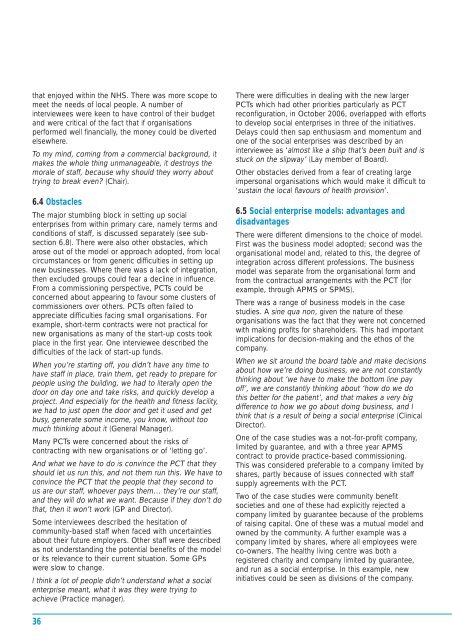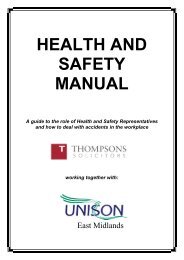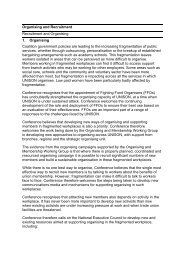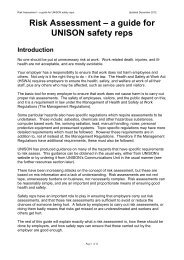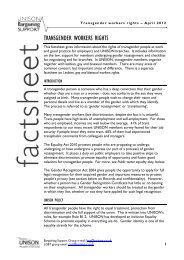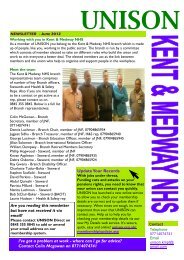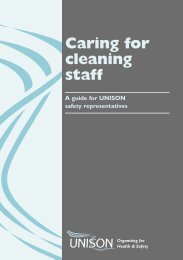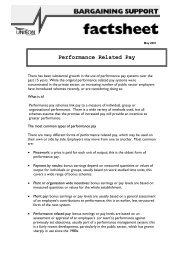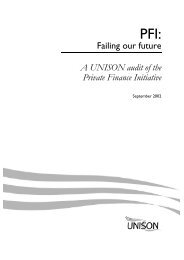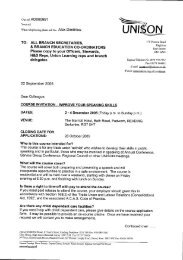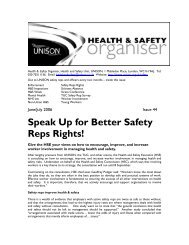Social Enterprises and the NHS - Unison
Social Enterprises and the NHS - Unison
Social Enterprises and the NHS - Unison
Create successful ePaper yourself
Turn your PDF publications into a flip-book with our unique Google optimized e-Paper software.
that enjoyed within <strong>the</strong> <strong>NHS</strong>. There was more scope to<br />
meet <strong>the</strong> needs of local people. A number of<br />
interviewees were keen to have control of <strong>the</strong>ir budget<br />
<strong>and</strong> were critical of <strong>the</strong> fact that if organisations<br />
performed well financially, <strong>the</strong> money could be diverted<br />
elsewhere.<br />
To my mind, coming from a commercial background, it<br />
makes <strong>the</strong> whole thing unmanageable, it destroys <strong>the</strong><br />
morale of staff, because why should <strong>the</strong>y worry about<br />
trying to break even? (Chair).<br />
6.4 Obstacles<br />
The major stumbling block in setting up social<br />
enterprises from within primary care, namely terms <strong>and</strong><br />
conditions of staff, is discussed separately (see subsection<br />
6.8). There were also o<strong>the</strong>r obstacles, which<br />
arose out of <strong>the</strong> model or approach adopted, from local<br />
circumstances or from generic difficulties in setting up<br />
new businesses. Where <strong>the</strong>re was a lack of integration,<br />
<strong>the</strong>n excluded groups could fear a decline in influence.<br />
From a commissioning perspective, PCTs could be<br />
concerned about appearing to favour some clusters of<br />
commissioners over o<strong>the</strong>rs. PCTs often failed to<br />
appreciate difficulties facing small organisations. For<br />
example, short-term contracts were not practical for<br />
new organisations as many of <strong>the</strong> start-up costs took<br />
place in <strong>the</strong> first year. One interviewee described <strong>the</strong><br />
difficulties of <strong>the</strong> lack of start-up funds.<br />
When you’re starting off, you didn’t have any time to<br />
have staff in place, train <strong>the</strong>m, get ready to prepare for<br />
people using <strong>the</strong> building, we had to literally open <strong>the</strong><br />
door on day one <strong>and</strong> take risks, <strong>and</strong> quickly develop a<br />
project. And especially for <strong>the</strong> health <strong>and</strong> fitness facility,<br />
we had to just open <strong>the</strong> door <strong>and</strong> get it used <strong>and</strong> get<br />
busy, generate some income, you know, without too<br />
much thinking about it (General Manager).<br />
Many PCTs were concerned about <strong>the</strong> risks of<br />
contracting with new organisations or of ‘letting go’.<br />
And what we have to do is convince <strong>the</strong> PCT that <strong>the</strong>y<br />
should let us run this, <strong>and</strong> not <strong>the</strong>m run this. We have to<br />
convince <strong>the</strong> PCT that <strong>the</strong> people that <strong>the</strong>y second to<br />
us are our staff, whoever pays <strong>the</strong>m… <strong>the</strong>y’re our staff,<br />
<strong>and</strong> <strong>the</strong>y will do what we want. Because if <strong>the</strong>y don’t do<br />
that, <strong>the</strong>n it won’t work (GP <strong>and</strong> Director).<br />
Some interviewees described <strong>the</strong> hesitation of<br />
community-based staff when faced with uncertainties<br />
about <strong>the</strong>ir future employers. O<strong>the</strong>r staff were described<br />
as not underst<strong>and</strong>ing <strong>the</strong> potential benefits of <strong>the</strong> model<br />
or its relevance to <strong>the</strong>ir current situation. Some GPs<br />
were slow to change.<br />
I think a lot of people didn’t underst<strong>and</strong> what a social<br />
enterprise meant, what it was <strong>the</strong>y were trying to<br />
achieve (Practice manager).<br />
36<br />
There were difficulties in dealing with <strong>the</strong> new larger<br />
PCTs which had o<strong>the</strong>r priorities particularly as PCT<br />
reconfiguration, in October 2006, overlapped with efforts<br />
to develop social enterprises in three of <strong>the</strong> initiatives.<br />
Delays could <strong>the</strong>n sap enthusiasm <strong>and</strong> momentum <strong>and</strong><br />
one of <strong>the</strong> social enterprises was described by an<br />
interviewee as ‘almost like a ship that’s been built <strong>and</strong> is<br />
stuck on <strong>the</strong> slipway’ (Lay member of Board).<br />
O<strong>the</strong>r obstacles derived from a fear of creating large<br />
impersonal organisations which would make it difficult to<br />
‘sustain <strong>the</strong> local flavours of health provision’.<br />
6.5 <strong>Social</strong> enterprise models: advantages <strong>and</strong><br />
disadvantages<br />
There were different dimensions to <strong>the</strong> choice of model.<br />
First was <strong>the</strong> business model adopted; second was <strong>the</strong><br />
organisational model <strong>and</strong>, related to this, <strong>the</strong> degree of<br />
integration across different professions. The business<br />
model was separate from <strong>the</strong> organisational form <strong>and</strong><br />
from <strong>the</strong> contractual arrangements with <strong>the</strong> PCT (for<br />
example, through APMS or SPMS).<br />
There was a range of business models in <strong>the</strong> case<br />
studies. A sine qua non, given <strong>the</strong> nature of <strong>the</strong>se<br />
organisations was <strong>the</strong> fact that <strong>the</strong>y were not concerned<br />
with making profits for shareholders. This had important<br />
implications for decision-making <strong>and</strong> <strong>the</strong> ethos of <strong>the</strong><br />
company.<br />
When we sit around <strong>the</strong> board table <strong>and</strong> make decisions<br />
about how we’re doing business, we are not constantly<br />
thinking about ‘we have to make <strong>the</strong> bottom line pay<br />
off’, we are constantly thinking about ‘how do we do<br />
this better for <strong>the</strong> patient’, <strong>and</strong> that makes a very big<br />
difference to how we go about doing business, <strong>and</strong> I<br />
think that is a result of being a social enterprise (Clinical<br />
Director).<br />
One of <strong>the</strong> case studies was a not-for-profit company,<br />
limited by guarantee, <strong>and</strong> with a three year APMS<br />
contract to provide practice-based commissioning.<br />
This was considered preferable to a company limited by<br />
shares, partly because of issues connected with staff<br />
supply agreements with <strong>the</strong> PCT.<br />
Two of <strong>the</strong> case studies were community benefit<br />
societies <strong>and</strong> one of <strong>the</strong>se had explicitly rejected a<br />
company limited by guarantee because of <strong>the</strong> problems<br />
of raising capital. One of <strong>the</strong>se was a mutual model <strong>and</strong><br />
owned by <strong>the</strong> community. A fur<strong>the</strong>r example was a<br />
company limited by shares, where all employees were<br />
co-owners. The healthy living centre was both a<br />
registered charity <strong>and</strong> company limited by guarantee,<br />
<strong>and</strong> run as a social enterprise. In this example, new<br />
initiatives could be seen as divisions of <strong>the</strong> company.


